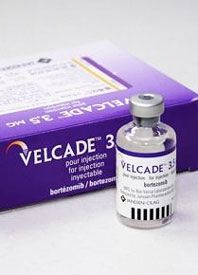Final Analysis of VISTA Upholds Survival Benefit of Bortezomib at 5 Years: No Increase in Secondary Malignancies Found
The phase III VISTA trial upholds a persistent and statistically significant survival benefit for bortezomib in previously untreated multiple myeloma patients.

The final analysis of the phase III VISTA trial upholds a persistent and statistically significant survival benefit for bortezomib in previously untreated multiple myeloma patients, who lived an average of 13.3 months longer than patients receiving a regimen without bortezomib, VISTA investigators reported at the 53rd Annual Meeting of the American Society of Hematology.
“The overall survival benefit was seen across multiple prespecified patient subgroups and was maintained after 5 years’ follow-up and despite substantial use of novel agent-based salvage therapies,” said Jesús F. San Miguel, MD, PhD, head, Hematology department and professor of medicine at the Hospital Clinico Universitario in Salamanca, Spain.
The 5-year follow-up of the study of 655 previously untreated patients also showed no association between bortezomib-treated patients and the development of second primary cancers, which has been a recent topic of concern.
Data from the initial report of this international phase III trial showed that nine 6-week cycles of bortezomib-melphalan-prednisone (VMP) was superior to melphalan-prednisone (MP) in patients with previously untreated multiple myeloma. All efficacy endpoints favored VMP. At 36.7 months of follow-up, a second analysis confirmed continued overall survival (OS) benefit. The current report is the final updated OS analysis after 5 years of follow-up, which includes data on 95% of the original cohort.
5-Year Mortality Risk Reduced by 31%
At 5 years, mortality risk was reduced by 31% with the addition of bortezomib to the regimen, despite the significant use of subsequent therapy. Median OS was 56.4 months after treatment with VMP, versus 43.1 months in patients receiving MP, amounting to an absolute benefit of 13.3 additional months of life across all subgroups (P=0.0004). The 5-year OS rate was 46.0% with VMP versus 34.4% with MP, San Miguel reported.
Virtually all subgroups benefited significantly from bortezomib. Mortality was reduced in the VMP arm among patients aged 75 and older, who had a 29% reduction in risk of death; those with stage III disease (international staging system [ISS]), who had a 23% risk reduction; and those with creatinine clearance <60 mL/min, who had a 30% risk reduction, but the small subgroup of patients with documented high-risk cytogenetics did not demonstrate a difference between the treatments.
The median time to next treatment was also significantly longer with VMP: 27 months versus 19.2 months with MP (P<0.0001), and the treatment-free interval was 16.6 months versus 8.3 months (P<0.0001).
San Miguel said that the finding of no increased incidence of second primary malignancies should be reassuring. One percent of each arm developed a hematologic malignancy and 5% on VMP and 3% on MP developed a solid tumor. These rates are no higher than seen in the general population. He said that based on this study he is convinced that the long-term use of bortezomib is “completely safe.”
As for the best time to prescribe bortezomib to previously untreated patients, San Miguel noted that patients who received bortezomib as first-line treatment had longer OS than those who received bortezomib or other therapies in subsequent treatment lines during the 5-year follow-up. The findings “demonstrate the importance of providing optimal first-line treatment incorporating bortezomib,” he said, “rather than reserving bortezomib for salvage therapy and using conventional first-line treatment.”



